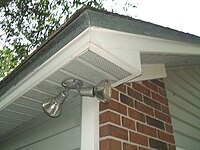Soffit: Difference between revisions
No edit summary |
Added list-item "soffit box" for kitchen ventilation hoods |
||
| Line 11: | Line 11: | ||
* the exposed undersurface of any exterior [[Overhang (architecture)|overhanging]] section of a roof [[eaves|eave]]. |
* the exposed undersurface of any exterior [[Overhang (architecture)|overhanging]] section of a roof [[eaves|eave]]. |
||
* the wall into which loudspeakers are mounted in a recording studio. |
* the wall into which loudspeakers are mounted in a recording studio. |
||
* a drop-down box used to mount a kitchen ventilation hood. |
|||
In popular use, ''soffit'' most often refers to the material forming a ceiling from the top of an exterior house wall to the outer edge of the roof, i.e., bridging the gap between a home's [[siding]] and the roofline, otherwise known as the [[eaves]]. When so constructed, the soffit material is typically screwed or nailed to rafters known as [[Lookout (architecture)|lookout]] rafters or lookouts for short. |
In popular use, ''soffit'' most often refers to the material forming a ceiling from the top of an exterior house wall to the outer edge of the roof, i.e., bridging the gap between a home's [[siding]] and the roofline, otherwise known as the [[eaves]]. When so constructed, the soffit material is typically screwed or nailed to rafters known as [[Lookout (architecture)|lookout]] rafters or lookouts for short. |
||
Revision as of 17:05, 15 November 2012
This article relies largely or entirely on a single source. (March 2012) |
This article includes a list of references, related reading, or external links, but its sources remain unclear because it lacks inline citations. (March 2012) |


Soffit (from French soffite, formed as a ceiling; directly from suffictus for suffixus, Latin suffigere, to fix underneath), in architecture, describes the underside of any construction element. Examples of soffits include:
- the underside of an arch or architrave (whether supported by piers or columns),
- the underside of a flight of stairs, under the classical entablature,
- the underside of a projecting cornice, or side of chimney
- the underside of a ceiling to fill the space above the kitchen cabinets, at the corner of the ceiling and wall,
- the exposed undersurface of any exterior overhanging section of a roof eave.
- the wall into which loudspeakers are mounted in a recording studio.
- a drop-down box used to mount a kitchen ventilation hood.
In popular use, soffit most often refers to the material forming a ceiling from the top of an exterior house wall to the outer edge of the roof, i.e., bridging the gap between a home's siding and the roofline, otherwise known as the eaves. When so constructed, the soffit material is typically screwed or nailed to rafters known as lookout rafters or lookouts for short.
Soffit exposure profile (from wall to fascia) on a building's exterior can vary from a few centimetres (2-3 inches) to 3 feet or more, depending on construction. It can be non-ventilated or ventilated for cooling non livable attic space.
In recording studios, historically, monitor speakers were either soffit mounted, i.e. attached to the wall, tight to the underside of the ceiling, or free standing. Mounted to the ceiling, the speaker radiates into quarter-space (π/2 steradians), and so achieves greater efficiency than its free-standing equivalent. The nomenclature has since been habitually used to denote any arrangement where the loudspeaker radiates into less than full space, most notably including flush mounting the speaker into a false wall constructed specifically for the purpose,to radiate into half-space (π steradians). The term 'speaker walls', or, as these walls are invariably built at an angle, simply 'flares' is preferable, particularly when discussing their construction with a builder, who will assume, when one says 'soffit' one means the ceiling, or the lower face of a beam.
See also
References
- This article incorporates text from a publication now in the public domain: Chisholm, Hugh, ed. (1911). Encyclopædia Britannica (11th ed.). Cambridge University Press.
{{cite encyclopedia}}: Missing or empty|title=(help)
